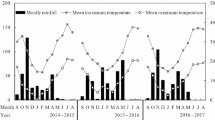Abstract
In Ethiopia, lack of quality forage in adequate quantities is a major constraint to livestock productivity. Fast growing N2 fixing Sesbania have shown great promise both as high quality fodder and green manure. The objective of this study was to evaluate and select among the species S. macrantha, S. rostrata, S quadrata and S. sesban for fodder yield, quality and green manure potential. The field experiment was conducted on a light soil (loam, Alfisol) and a heavy soil (cracking type clay, Vertisol) at Debre Zeit (9° N and 39° E, 45 kms SE of Addis Ababa). There were two cutting treatments: cutting once at ground level or cutting twice at 50 cm (first, 65 days after sowing; second, 40 days later). A two-factor factorial in randomized block design was used. S. macrantha performed better on the light soil producing the highest dry matter (DM) yields of leaf (2.8 t/ha), stem (6.3 t/ha) and total nitrogen (151 kg/ha) in 105 days than the rest of the species. Most species performed poorly on the heavy soil. S. quadrata, however, showed better adaptability to the heavy soil (5.5 t/ha DM) than any of the other species. The lowest DM yield was recorded for S. rostrat which could be due to poor nodulation. Cutting twice over the 105 days growth period caused a drastic reduction in DM yield, but resulted in higher leaf-to-stem ratio and total N yield. The nutritional composition of all the species was within an acceptable range for livestock requirements. N content (4%) and IVDMD (over 70%) were high. S. macrantha had superior overall performance and seems promising both as high quality fodder and green manure crop. Under rain-fed conditions, cutting once was better than cutting twice particularly for S. macrantha.
Similar content being viewed by others
References
Akkasaeng R, Gutteridge RC and Wanapat M (1989) Evaluation of trees and shrubs for forage and Fuelwood in North-East Thailand. International Tree Crops Journal 5(4): 209-220
Association of Official Analytical Chemists (AOAC) (1975) Official Methods of Analysis, 12th ed. Association of Official Analytical Chemists, Washington DC
Brewbaker JL, Macklin B and Evans DO (1990) The perennial sesbanias. In: Evans DO and Macklin B (eds) Perennial Sesbania Production and Use. Nitrogen Fixing Tree Association (NFTA). Waimanalo, Hawaii, USA, pp 7-12
Brockwell J (1980) Experiments with crop and pastures legumes-principles and practice. In: Bergersen FG (ed) Methods for Evaluating Biological Nitrogen Fixation, pp 418-488. John Wiley and Sons Ltd
Dreyfus B, Garcia JL and Gillis M (1988) Characterization of Azorhizobium caulinodans Gen. Nov., Sp. Nov., a stem-nodulating nitrogen fixing bacterium isolated from Sesbania rostrata. International Journal of Systematic Bacteriology 38(1): 89-98
Evans DO and Rotar PP (1987a) Sesbania in Agriculture. Westview Tropical Agriculture Series No. 8. Westview Press, Boulder, Colorado (USA), p 192
Evans DO and Rotar PP (1987b) Productivity of Sesbania species. Tropical Agriculture (Trinidad) 64(3): 193-200
FAO-UNDP (Food and Agricultural Organization-United Nations Development Program) (1990) FAO-UNDP Assistance to Land Use Planning Project/Ministry of Agriculture Meteorological Data
Goering HK and Van Soest PJ (1967) Effect of moisture, tem-perature and pH on the relative susceptibility of forages to non-enzymatic browning. J Dairy Sci 50: 989
Goering HK and Van Soest PJ (1970) Forage Fiber Analysis. U.S.D.A. Agricultural and Handbook No. 379. Washington DC
Gomez KA and Gomez AA (1984) Statistical Procedures for Agricultural Research (Second ed.) John Willey and Sons, New York, pp 89-97
Holden SR, Lungu S and Volk J (1989) Growth rate and coppicing ability of Sesbania macrantha after repeated prunnings at various heights. NFTRR 7: 132-134
Jutzi S and Mesfin A (1987) Improved agricultural utiliza-tion of Vertisols in the Ethiopian highlands. An inter-institutional approach to research and development. Paper presented at the First International Board for Soil Research and Management (IBSRAM) on improved vertisol man-agement, Nairobi, Kenya, 1-6 December 1986, pp 173-183
Ladha JK, Pareeck RP and Becker M (1992) Stem-nodulating legume-Rhizobium symbiosis and its agronomic use in lowland rice. In: Stewart BE (ed) Advances in Soil Science. Volume 20, pp 147-192. Springer-Verlag, New York
Lulseged GH and Alemu T (1985) Pasture research and development in Ethiopia. In: Kategile JA (ed) Pasture Improvement in Eastern and Southern Africa. Proceedings of a workshop held in Harare, Zimbabwe 17-21 Sept. 1984, pp 77-91. IDRC, Ottawa, Canada
Mesfin A (1980) State of soil science development for agri-culture in Ethiopia. Ethiopian Journal of Agricultural Sciences 2 (2): 139-157
Reed JD, Soller H and Woodward A (1990) Fodder tree and straw diets for sheep: intake, growth, digestibility and the effects of phenolics on nitrogen utilization. Animal Feed Science and Technology 30: 39-50
Siaw D, Kahsay B and Tothill JC (1993) Screening of two Sesbania species for fodder potential and response to phos-phorus application on an acid soil in Ethiopia. In: Kategile JA and Adoutan SB (eds) Collaborative Research on Sesbania in East and Southern Africa, Proceedings of an AFRNET Workshop held in Nairobi Kenya, 9-14 Sept 1991, pp 91-102. ILCA, Nairobi, Kenya
Solomon M (1990) Report of a survey and collection mission for Sesbania germplasm in Tanzania. In: Macklin B and Evans DO (eds) Perennial Sesbania Species in Agroforestry Systems. Special Publication of the NFTA 90-01, pp 221-230. Waimanalo, Hawaii, USA
Tilley JMA and Terry RA (1964) A two-stage technique for in vitro digestion of forage crops. J Brit Grassland Soc 18: 104-111
Tothill JC, Reed J and Asres T (1989) Genetic resources and fodder quality in Sesbania. In: Macklin B and Evans DO (eds) Perennial Sesbania species in Agroforestry Systems. Nitrogen Fixing Tree Research Reports, Special Publication of the NFTA 90-01, pp 221-230. Waimanalo, Hawaii, USA
Author information
Authors and Affiliations
Corresponding author
Rights and permissions
About this article
Cite this article
Mengistu, S., Keftasa, D. & Yami, A. Productivity of four sesbania species on two soil types in Ethiopia. Agroforestry Systems 54, 235–244 (2002). https://doi.org/10.1023/A:1016072504983
Issue Date:
DOI: https://doi.org/10.1023/A:1016072504983




